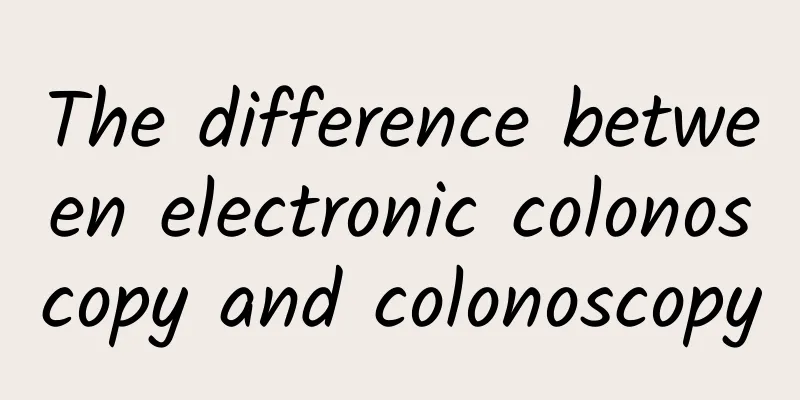The difference between electronic colonoscopy and colonoscopy

|
There are many types of colonoscopes, some are traditional, and some are electronic colonoscopes developed through electronic means. Nowadays, most people choose a newer type when doing a colonoscopy, which is less painful, does not require direct in-depth examination, and will not cause side effects. Let us take a look at the difference between electronic colonoscopes and colonoscopes. Electronic Colonoscopy Overview Electronic colonoscopy is a method of inserting a colonoscope through the anus into the ileocecal cavity and observing colon lesions from the mucosal side. It is currently the best choice for diagnosing colorectal mucosal lesions. It transmits the image of the colon mucosa to the electronic computer processing center through the electronic camera probe installed at the front end of the colonoscope, and then displays it on the monitor screen. It can observe subtle changes in the colorectal mucosa, such as cancer, polyps, ulcers, erosions, bleeding, pigmentation, varicose and dilated blood vessels, congestion, edema, etc., and the image is clear and realistic. Electronic colonoscopes can also use the instrument channel of the colonoscope to insert biopsy forceps to obtain rice-grain-sized tissue for pathological section testing or other special staining, and conduct histological characterization of the nature of mucosal lesions, such as the degree of inflammation, the degree of differentiation of cancer, etc. Further grading is helpful in understanding the severity of the lesions, guiding the formulation of correct treatment plans or judging the effectiveness of treatment. Endoscopic treatment can also be performed on some colon diseases or lesions such as polyps, bleeding, foreign bodies, etc. through the colonoscope instrument channel. Clinical significance of colonoscopy Applicable diseases: colorectal polyps; colorectal inflammatory diseases such as ulcerative colitis; chronic colitis; colon cancer, etc. Indications The indications for electronic colonoscopy are quite broad. Electronic colonoscopy can be performed in any of the following situations without contraindications. 1. Unexplained lower gastrointestinal bleeding. 2. Chronic diarrhea of unknown cause. 3. Unexplained abdominal mass, where lesions of the large intestine and terminal ileum cannot be ruled out. 4. Unexplained pain in the lower abdomen. 5. Patients suspected of having benign or malignant colon tumors, but cannot be diagnosed by X-ray examination. 6. Suspected of having chronic inflammatory intestinal disease. 7. If abnormalities are found during barium enema or intestinal examination, the nature and extent of the lesions need to be further clarified. 8. Determine the extent of lesions before colon cancer surgery, and conduct reexamination and follow-up of efficacy of colon cancer and polyps surgery. 9. Low intestinal obstruction of unknown cause. Colonoscopy is no longer as painful as people imagined in the past, and most people can tolerate it. In addition: Patients can also request a painless colonoscopy under general anesthesia. When you take a nap, the colonoscopy will be done, but the risks of general anesthesia cannot be ignored. Contraindications of electronic colonoscopy: Endoscopic examination should not be performed when the anal canal and rectum are narrow and the endoscope cannot be inserted. Patients with symptoms of peritoneal irritation, such as intestinal perforation, peritonitis, etc., are contraindicated in undergoing this examination. Avoid colonoscopy if there is acute infection of the anorectal canal or painful lesions, such as anal fissures or perianal abscesses. Women should not be examined during menstruation and should be examined with caution during pregnancy. People who are elderly, frail, have severe hypertension, anemia, coronary heart disease, or heart and lung failure should not undergo endoscopic examination. This examination is contraindicated in patients who are suspected of having perforation, intestinal fistula, or extensive abdominal adhesions in the early stage after abdominal or pelvic surgery. |
<<: Three-point positioning method for femoral vein puncture
>>: Differences between bacteria, fungi and viruses
Recommend
What are white granulations on the genitals?
If white granulations grow on the genitals, you s...
Red pimples on face and arms
Skin diseases are difficult for the human body to...
What are the effects of Zhenqi Fuzheng Granules?
Nowadays, getting sick has become a common phenom...
What can pregnant women do to enlarge their breasts during pregnancy?
People often say that no matter how small your br...
Vascular Parkinson's syndrome
Vascular Parkinson's syndrome is a disease cl...
What medicine should be used to treat tinea capitis?
The scalp is different from other parts of the sk...
What are the symptoms of femoral neck necrosis?
The most obvious symptom of femoral neck necrosis...
What to do if your face turns red without sweating
There is no sweating on the face, but there is re...
Chinese patent medicine for Qi and Yin deficiency
Qi and Yin deficiency is generally manifested by ...
How to treat dampness and heat in men?
In modern life, people attach great importance to...
What's going on if a child suddenly twitches and rolls his eyes?
Children's health is easily affected by factor...
Breast augmentation pros and cons
Many women pay great attention to having a good c...
How to treat finger osteoarthritis?
Fingers are very flexible because they have the m...
What is the cause of right foot back pain
Pain in the right instep may be caused by fasciit...
Symptoms of mumps
Mumps is a very common disease in our lives. It o...









